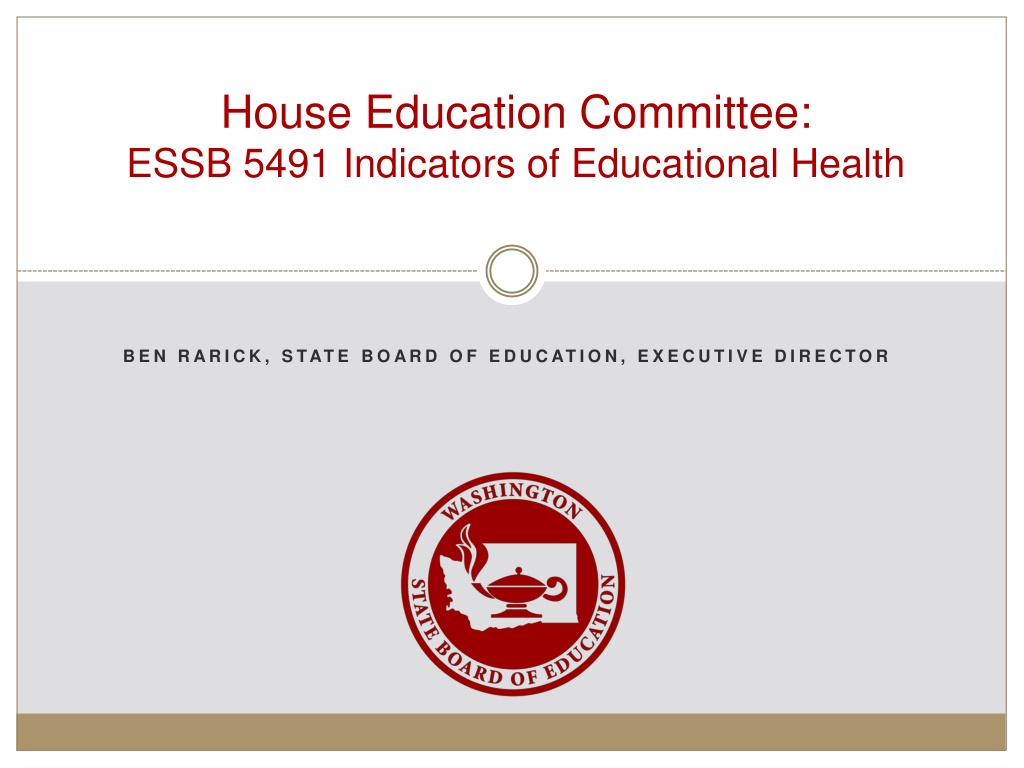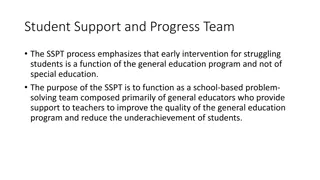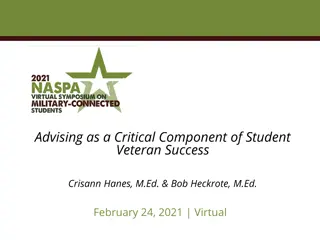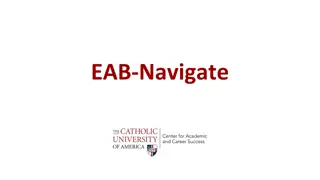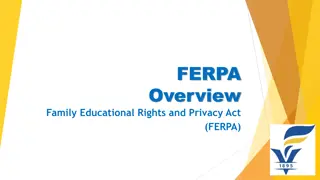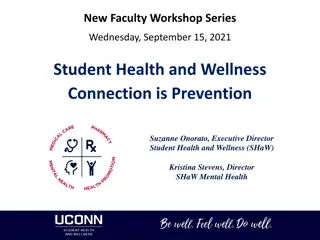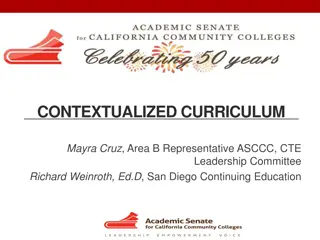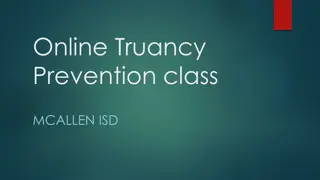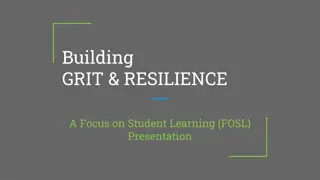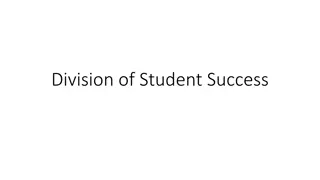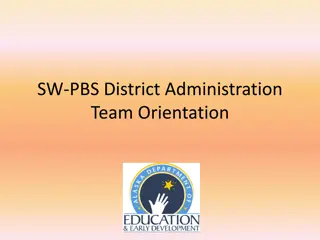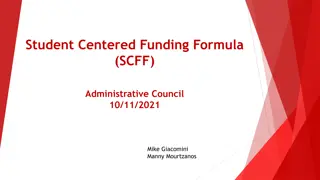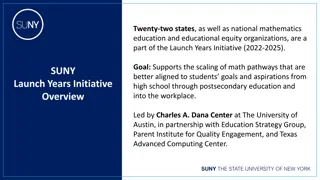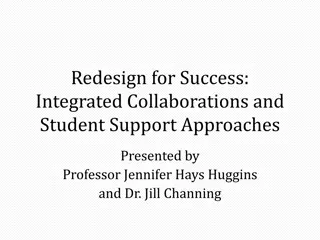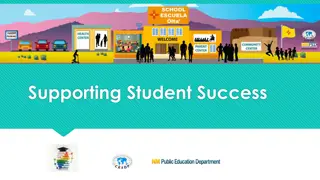Enhancing Educational Health for Student Success
The House Education Committee discusses ESSB 5491 and the indicators of educational health, emphasizing the importance of all students planning for education beyond high school. Stakeholders provide input to align with recent research and systemic measures for postsecondary attainment. Data on growth vs. proficiency and reading growth gaps highlight the need for closing opportunity gaps. Guiding principles aim to meet requirements, foster improvement, and deliver the best education possible while planning for the future.
Download Presentation

Please find below an Image/Link to download the presentation.
The content on the website is provided AS IS for your information and personal use only. It may not be sold, licensed, or shared on other websites without obtaining consent from the author. Download presentation by click this link. If you encounter any issues during the download, it is possible that the publisher has removed the file from their server.
E N D
Presentation Transcript
House Education Committee: ESSB 5491 Indicators of Educational Health B E N R AR I C K , S TAT E B O AR D O F E D U C AT I O N , E X E C U T I V E D I R E C TO R
Systems Perspective on Educational Health Attainment is the ultimate objective of the educational system All students should be planning for education or training beyond high school Closing the large and persistent opportunity gap is a requirement to reach this objective Integration and alignment across agencies is an enabling strategy to monitor system health
Guiding Principles Meet the requirements of ESSB 5491 Build on the learning and conversations underway across agencies The goal is not always obvious Improvement takes time & resources System alignment is a key goal Deliver the best we can today and plan for a better future
Stakeholder Input on ESSB 5491 Partner agencies, Achievement and Accountability Workgroup, and district and ESD leadership Key stakeholder input Need a phased approach to account for changes in assessments Raise the prominence of English language acquisition Increased rigor: Writing & Science are missing Align and leverage district and school accountability measures Align with recent research on systemic measures of leading indicators toward postsecondary attainment
Growth vs. ProficiencyThe Gap Changes Fourth Grade Reading Proficiency, 2012-2013 100.0% Percentage of Students Meeting Standard (% METSTD) 90.0% 82.7% 78.1% 80.0% 75.1% 72.4% 70.0% 60.9% 59.9% 57.7% 60.0% 55.5% 53.9% 50.0% 42.1% 40.0% 33.8% 30.0% 20.0% 10.0% 0.0% Asian White Two or More Races All Students Low Income Black Hispanic Pacific Islander American Indian Special Education Limited English Washington State Board of Education
Reading Growth Gap Student Growth Percentiles at the Median School for Each Student Group, 2011-2012 Key point: Growth gaps and opportunity gaps are not the same (e.g. LEP and Sp.Ed opportunity gaps appear larger than growth gaps) 100.0% Median Student Growth Percentile (SGP) 90.0% 80.0% 70.0% 55.5% 60.0% 50.5% 50.0% 50.0% 48.0% 47.0% 46.0% 46.0% 50.0% 42.0% 39.8% 37.5% 40.0% 30.0% 20.0% 10.0% 0.0% Asian White All Students Two or More Races Hispanic or Latino Low Income Black or African American Limited English Special Education American Indian or Alaskan Native Hawaiian or Pacific Islander Washington State Board of Education
Goals Need to be Sensitive to Diversity of Student Needs Washington State Board of Education
Specific Indicators in ESSB 5491 (Current Law) (1) The following statewide indicators of educational system health are established: (a) The percentage of students demonstrating the characteristics of entering kindergartners in all six areas identified by the Washington kindergarten inventory of developing skills administered in accordance with RCW 28A.655.080; (b) The percentage of students meeting the standard on the fourth grade statewide reading assessment administered in accordance with RCW 28A.655.070; (c) The percentage of students meeting the standard on the eighth grade statewide mathematics assessment administered in accordance with RCW 28A.655.070; (d) The four-year cohort high school graduation rate; (e) The percentage of high school graduates who during the second quarter after graduation are either enrolled in postsecondary education or training or are employed, and the percentage during the fourth quarter after graduation who are either enrolled in postsecondary education or training or are employed; and (f) The percentage of students enrolled in precollege or remedial courses in college.
The Gap Starts Early Percent of Students who Demonstrate Characteristics of Entering Kindergartners in Multiple Domains (Fall 2012) 100.0% 90.0% 80.0% 70.0% 60.0% 50.3% 50.0% 42.1% 41.3% 37.2% 40.0% 30.4% 30.2% 30.1% 23.9% 30.0% 19.0% 16.2% 20.0% 10.0% 0.0% All Students American Indian / Alaskan Native Asian Pacific Islander Black / African Hispanic White Limited English (ELL) Students with Disabilities (SpEd) Low-Income American Washington State Board of Education
Bridge the Gap Between High School and Postsecondary Remedial Course-taking: Percentage of Students Enrolled in Precollege or Remedial Courses 100% 90% 2-Year Schools: Change per year: -0.2 percentage points per year. 4-Year Schools: Change per year: -0.2 percentage points per year. 80% 70% 60% 50% 40% 30% 20% 10% 0% 2007 2008 2009 2010 2011 All Students at 4 Year Schools All Students at 2 Year Schools Washington State Board of Education
December 2013 Initial Report Details for each of the ESSB 5491-specified indicators status of each data element goals for each indicator Focus is on refinement for the future based on the conversations occurring across agencies additional and different indicators necessity for resetting goals (CCSS and SBAC) SBAC field test flexibility
Recommended Revisions Key Indicator: Postsecondary Attainment The percentage of high school graduates attaining certificates, credentials (AA/BA), and completing qualified apprenticeships by age 26 The percentage of high school graduates who during the second quarter after graduation are either enrolled in postsecondary education or training or are employed, and the percentage during the fourth quarter after graduation who are either enrolled in postsecondary education or training or are employed
Recommended Revisions Quality of Secondary Diploma The percentage of high school graduates enrolled in precollege or remedial courses in public postsecondary educational institutions (within 4 years of high school graduation) The percentage of students meeting standard on the 11th grade SBAC College and Career Readiness Assessment The percentage of students who have reached English language proficiency on the state language proficiency assessment in grades K-11 Washington State Board of Education
Recommended Revisions Extended 5-Year Graduation Rate The percent of students graduating using the 5-year (extended) graduation rate data Supporting indicator (per ESSB 5491): 4-year cohort graduation rate Washington State Board of Education
Recommended Revisions 8th Grade Readiness for High School Reading, Math, and Science: The percent of students meeting standard on 8th grade state assessments English Language Acquisition: The percentage of students who have reached English language proficiency on the state language proficiency assessment in grades K-8 Growth Gap Indicator: The percentage decrease in student growth percentiles (using Achievement Index Growth measure) Washington State Board of Education
Recommended Revisions 3rd Grade Reading The percent of students meeting standard on the third grade Reading (English / Language Arts under the Common Core State Standards) assessment The percentage of students who have reached English language proficiency on the state language proficiency assessment in grades K-3 Washington State Board of Education
Recommended Revisions Kindergarten Readiness Percent of students demonstrating the characteristics of entering kindergarteners on all six areas of Wa-KIDS Access to Quality Schools The percent of students attending schools at, or above, the Good tier of the revised OSPI/State Board of Education Achievement Index Washington State Board of Education
Summary: System Perspective Attainment is the ultimate objective of the educational system Closing the large and persistent opportunity gap is a requirement to reach this objective Monitoring student growth rates is essential Integration and alignment across agencies is an enabling strategy to monitor system health
ESSB 5491 Goal Summary: Application of Initial Targets Indicator Current State Comparative across states or Nation? Change per year (PPPY=percentage points per year) 2020 Endpoint 2012-2013 results Goal- Change Per Year 2013- 14 Goal 2012. N=20,700 students in 118 schools. Biased toward high- need schools. Stable with extensive historical data. Stable with extensive historical data. Stable with extensive historical data WA-KIDS: Percent of students who demonstrate the characteristics of entering kindergartners in all 6 domains No N/A +5.2 42.4% 68.6% 37.2% 4th Grade Reading No 72.4% +0.19 PPPY +2.3 74.3% 85.8% 8th Grade Math No 53.2% +0.87 PPPY +3.9 58.3% 77.8% High School Graduation Rate- 4 Year Cohort Yes +1.35 PPPY +1.9 79.1% 88.5% 77.2% Percents of graduates enrolled or employed in 2nd and 4th quarter after graduation Postsecondary Education All students Yes -0.10 PPPY +3.3 63.3% 80.0% 60% Approx. 50% of graduates w/ SSN Postsecondary Employment Percentage of students enrolled in precollege or remedial courses TBD TBD TBD TBD TBD TBD Attending 2-Year Attending 4-Year Stable Stable Yes Yes 57.0% 11.0% -0.20 PPPY -0.20 PPPY -4.8 -.96 52.7% 10.5% 28.8% 5.8% Washington State Board of Education
